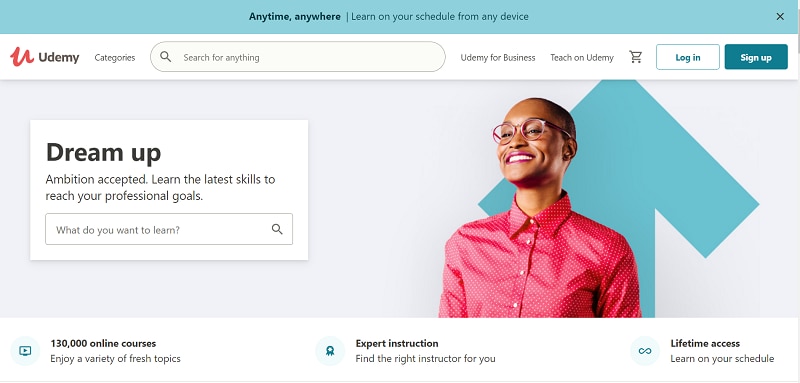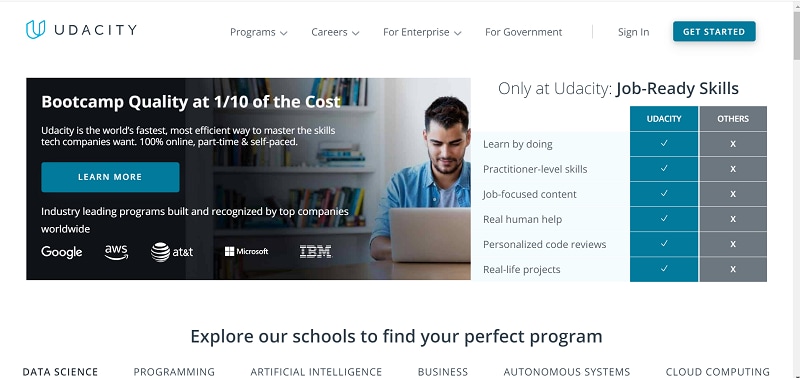Understanding the Differences between Udemy, Udacity, and Coursera
Some people learn to grow, others learn to expand their horizons, and some learn to become more competitive. Whatever the reason may be, learning should never stop. Online courses, studies, and educational content have managed to help individuals become a better version of themselves.
A big part in the individual's growth has been played by massive open online course platforms, at least in recent years. In this respect, online platforms like Udemy, Udacity, and Coursera cannot be missed.
This article is about Udemy vs Udacity and Udacity vs Coursera. We will understand what these platforms do and how they differ from each other. It will help you figure out which online course platform is good for you and why.
- Part 1: What is Udemy?
- Part 2: What is Udacity?
- Part 3: What is Coursera?
- Part 4: Udemy vs Udacity vs Coursera, Which One to Choose?
- Part 5: Prototyping Tool You Will Need
What is Udemy?

Udemy is a Massive Open Online Course with 35 million users and millions of hours of courses. The best part about Udemy is that it arranges the courses into different modules and lessons. It has text assignments, video lectures, and tests to help the students analyze their performance.
The best part about Udemy is that it has over 130,000 courses available developed and made by 57,000 experts in 65 languages. Professionals from over 180 countries take part in developing these courses for users.
In prices, some courses are free, while access to others is subject to payment.
Key Features of Udemy:
- The arrangement of courses on Udemy is amazing and well-organized. There are 15 major categories and under each category, there are 15 more sub-categories. For each of these sub-categories, there are lessons about that subject.
- The students need not present some qualifications to start or join a course. So, this is a platform that considers the user's interest primary to everything else.
- There are no delays, conditions, or regulations to get access to the courses. The plug and play system of Udemy works beautifully well to accommodate any sort of student while taking care of the interests.
- Although there is no option to download the courses on the computer, the Udemy mobile application allows offline access in the podcast format.
What is Udacity?

Next, up in our discussion of Udemy vs Udacity, we will talk about the introduction and current standings of another amazing online learning platform. Udacity was born out of an experiment conducted at Stanford University by Sebastian Thrun and his team.
The first course provided by these experts was about Artificial Intelligence and it was given for free. No doubt that the course bagged an overwhelming response, which led to the addition of courses from other fields as well.
Today on Udacity, you can find courses for the subjects related to Programming and Development, AI, Cloud Computing, Data Science, Business, and Autonomous Systems.
Udacity is different from Udemy in the sense that it caters to specific fields and workforces. Not only does it cater to individual audiences, but there are specific and targeted programs for enterprises and the government.
Its impact on workforce development by developing and providing courses that align with specific goals. For other users, Udacity claims to provide job-ready knowledge. The information technology-led courses and programs make Udacity a great but a platform with limited accessibility.
Udacity's instructors and coaches are industry level experts sharing their expertise on the subject matters while adding their experience and real-world value to the course.
What is Coursera?

If you think about it, Udemy vs Coursera is a divergent topic because of the way these platforms are poles apart. Where Udemy is an open online course, Coursera partners up with world-renowned universities like Duke, Stanford, UC San Diego, Imperial College of London among others.
The content on Coursera is both free and paid. But the catch is that the free courses' acknowledgment is paid. This means that you can take the course for free, but its certificate will be paid for. However, the courses which involve a cost comes with a certificate included in the fee.
This makes Coursera a professional platform that has academic and professional validity. This accreditation from the world's top educational institutions makes Coursera a great platform to get jobs on the basis of vocational courses and show your eagerness to learn and grow.
Udemy vs Udacity vs Coursera, Which One to Choose?
Coming to identify the key differences between Udemy vs Udacity and Udemy vs Coursera. We will try to understand these differences on the basis of:
- Quality of the Course
The quality of the course is one of the first things that anyone should look at while selecting a platform for online studies. Everything else is connected to the quality. If the course content and quality is immaculate, any user would not hesitate to pay.
Starting with Udacity, the general response from the audience is good, when it comes to the quality. We can only generalize it because there are a lot of courses on the platform and the real value will only be provided with a case by case scenario.
With Udemy, from what we have understood is that the customers have a mixed response. This means that where some of the courses are actually worth taking, there are a few of them which may provide a sub-standard quality. The good thing about these courses on Udemy is they are made and marketed by the instructors themselves.
So, instead of a third party or a professional marketer doing the job, Udemy instructors take the lead and do it themselves.
Lastly, in Udemy vs Coursera, we can say that the latter has a better content quality for two reasons. One, the platform has links with top educational institutions across the globe. Two, the courses are provided by certified professionals, teachers, and professors associated with these institutions.
- Pricing Structure
The second most important aspect to choose in Udemy vs Udacity is the price. Where Coursera offers two types of pricing structure, one-time payments, and subscriptions, Udemy's course based prices are set by the instructors themselves.
The Udemy company does not play a role in setting the price. In Udacity vs Coursera, Udacity has a wide gamut of courses, some zero-cost while others are paid. Now, the paid courses are facilitated under the premise of Nanodegrees. The courses charge somewhere around $200 per month. So, with a three-month course, you will end up paying $600 for the entire course.
- Variety of the Courses
Udemy has thousands of courses covering almost every field and industry. So, in a bid to choose between Udemy vs Udacity, you can go with the former if you want to explore both technical and non-technical fields.
Udacity has fewer courses covering the fields of programming, data science, web development, software engineering, cloud, etc.
Coursera has a large repository of courses provided by professionals and experts. Because the platform is about reskilling and upskilling the workplaces, the courses also correspond to the requirements.
- Types of Coaches, Teachers, and Instructors
Udemy has individual instructors providing lessons from their fields of expertise. They can be authors, experts, professionals, entrepreneurs, leaders, and professors. On Udacity, you will find teachers and experts from the technical fields, and most of them are associated with a technology-related company. Coursera has courses made by the professors and teachers of top colleges and universities.
So, when it comes to deciding between Udemy vs Udacity or Udacity vs Coursera, it depends on your needs and requirements. If you are looking to build a career in your field and want to add to your skills with a certification, go with Coursera.
If you are an avid learner and like to explore new areas, go with Udemy's free courses or you can also take a certificate after paying for the same to show for your progress. Udacity gives you the ability to reskill and upskill yourself while letting you compete in the industry.
A successful online course is also about the layout and how you frame the entire structure. To create a good structure, you need a good prototyping tool in your hands.
Prototyping Tool You Will Need
There are a variety of prototyping tools that can help you develop layouts and content structures. Tools like Sketch, Figma, Balsamiq, InVision, Adobe Studio and Wondershare Mockitt can do the job beautifully.

Wondershare's Mockitt presents an easy method to not only create prototypes but test them in the actual interface of a website or a mobile device without writing any sort of code. Mockitt's integrated features and functions make it possible for beginners and expert designers to create bespoke prototypes.
There are customizable widgets, items, shapes, icons, and much more. To make the platform more interactive, you can also add some animations to the design. Mockitt is made to promote collective intelligence and to help you pursue it by allowing multiple members to work on the design.
Not only this, but you can also share the design with other members and import the previous design files made with Sketch. Mockitt takes the experience of prototyping to a whole new level.

